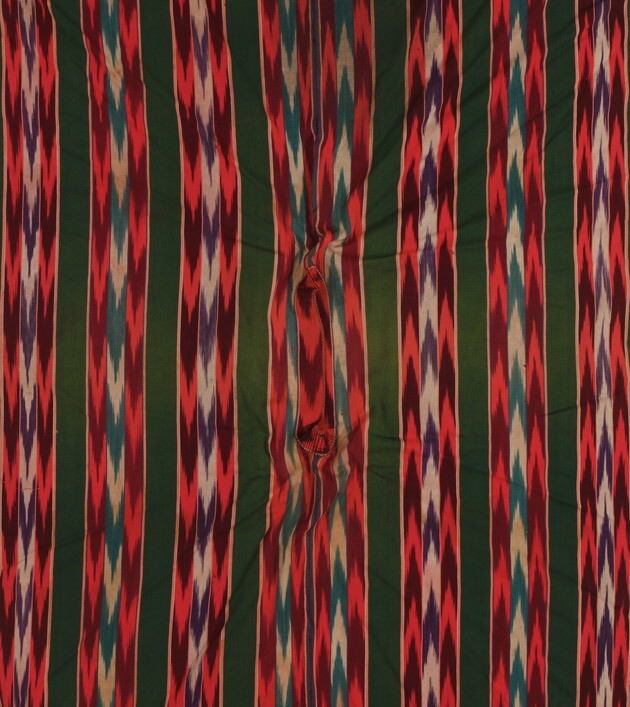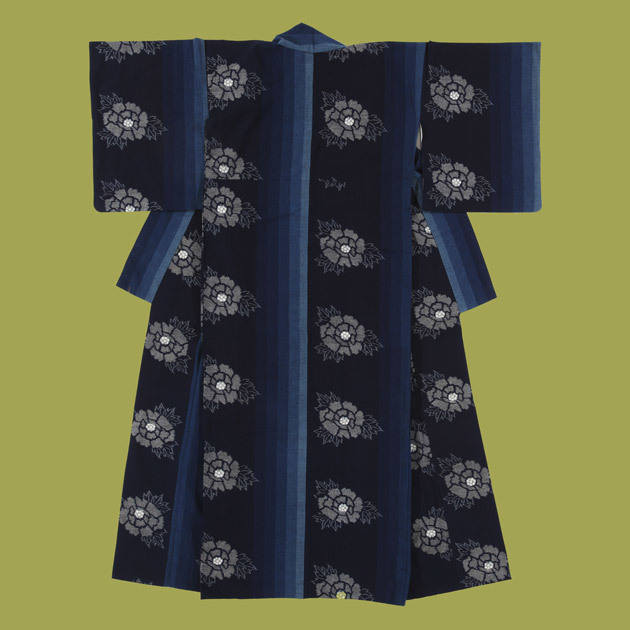Diamond(s) in the Rough
Review of Ikat: A World of Compelling Cloth presented by Seattle Art Museum
Written by Teen Writer Maitreyi Parakh and edited by Teen Editor Yoon Lee

Ikat: A World of Compelling Cloth is an exhibit that is very easy to brush over, though it is located prominently on the top floor of the Seattle Art Museum (SAM). The grandeur of the traditional European classic pieces awaits just beyond the door to the left, as well as a ceramics exhibit that will take your breath away. Next to these galleries, Ikat seems to be very ordinary indeed. Of course, it does open with a majestic display of woven strands dropping down from the planks at the top, resembling an optical illusion. As you turn around this display, each angle presents you with a different view of the threads and their scale, leaving you feeling somewhat disoriented. Justifiably, the piece takes up much of the entirety of the main room, allowing you to soak in its splendor and intrigue.

When you move on to much of the rest of the exhibit, though, you see a strikingly different approach being taken with the presentation of the pieces. The first thing you notice is the bright colors of the walls, surrounding and enveloping the pieces they surround. It's almost difficult to view the art on its own, seemingly messily done.
Pieces—primarily woven and knitted cloth—are organized by the region they came from, but there are still so many of them crowded next to each other that it can feel overwhelming. The lack of focus and overgeneralization facing isolated pieces makes it so that it can be difficult to absorb the exhibit itself—it's even tempting to leave the gallery altogether, just as I left.
Located almost immediately outside the exhibit is a display that features a video with different ikat makers discussing their process of crafting ikat. They echo the sentiment that "[e]ach thread's resistance to the dye is slightly different, which results in ikat's unique edge [...] Images hover inside the cloth, embedded, and serve as a reminder of the depth of dedication required to make an ikat." Conversely, faux ikat has become popularized in the fashion and interior furnishing industries and does not embrace the same tradition and meaning that real ikat does.
Initially, it feels as if the exhibit has bastardized the very thing it attempts to celebrate, by brushing over and only skimming the concepts of what ikat is. To me, it felt like each piece was so intricate, it deserved to be showcased like the central piece at the beginning—the descriptions of the pieces seemed to have been struck by the oversaturation of art, so these marvels were being pushed under the rug. Even when something was clearly spectacular, it was often described as rather mundane and commonplace.
However, as I came to understand the intent behind ikat, I reshaped my own perspective of the exhibit. Western art is saturated with the idea of the individual through self-personhood, as the neighboring gallery demonstrated.

Though several other exhibits at SAM (including American Art: The Stories We Carry) attempt to disillusion viewers of this notion, the unlearning curve is rather tough. To truly showcase the artists and allow them to blend together, this gallery allows them to coalesce but still retain their own individual threads that make up each piece. The contradiction between the detail and the oversight requires an understanding of the principles of ikat beyond what can be seen on the surface.
Ikat is more than simply an art form. It allows us to reconsider what we perceive to be art, placing a community as the artist and the inspiration to preserve culture and tradition over the harsh individuality we've become used to. Though it is a tough realization to reach, it is ultimately a rewarding one. Only when we look beyond the individual threads can we see the beauty of the whole piece, and only when we look beyond the individual can we see the beauty of a community's stories and history.
Lead Photo Credit: INSTALLATION VIEW OF IKAT: A WORLD OF COMPELLING CLOTH AT SEATTLE ART MUSEUM, 2023, PHOTO: ALBORZ KAMALIZAD.
The TeenTix Newsroom is a group of teen writers led by the Teen Editorial Staff. For each review, Newsroom writers work individually with a teen editor to polish their writing for publication. The Teen Editorial Staff is made up of 6 teens who curate the review portion of the TeenTix blog. More information about the Teen Editorial Staff can be found HERE.
The TeenTix Press Corps promotes critical thinking, communication, and information literacy through criticism and journalism practice for teens. For more information about the Press Corps program see HERE.

